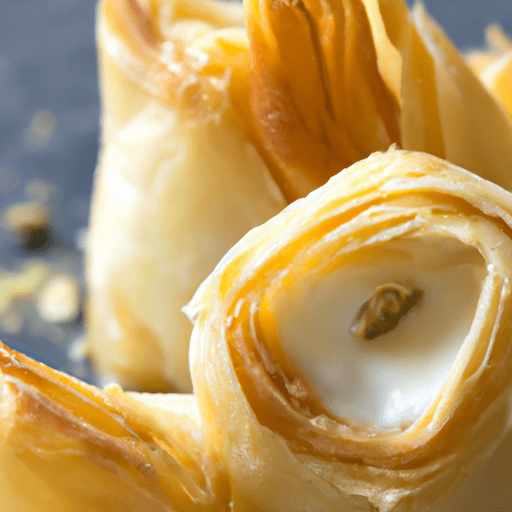Unveiling the Delicate Delight: Filo Dough
From flaky pies to savory pastries, filo dough is a culinary superstar that adds a touch of elegance to various dishes. Known for its delicate layers and incredible versatility, this paper-thin pastry has a rich culinary history and a charm that can tantalize even the most discerning taste buds. Join us as we dive into the world of filo dough, exploring its taste, culinary uses, nutritional value, and fascinating origins.
Taste Sensations in Every Crispy Bite
Imagine biting into a light and crispy pastry that effortlessly melts in your mouth. That’s the magic of filo dough. Made primarily with flour, water, and a touch of oil or butter, this dough has a neutral flavor that perfectly complements both sweet and savory fillings. Its paper-thin layers create a satisfying contrast between the crunchy exterior and the luxurious filling, making each bite an explosion of texture and taste.
Versatility at its Finest
Filo dough is a versatile ingredient that can be used to create an array of delectable dishes. In the realm of desserts, it can be transformed into beautifully flaky baklava, with its layers brushed generously with butter, sprinkled with nuts, and sweetened with honey or syrup. Alternatively, it can be creatively shaped into delicate strudels, croissants, or fruit-filled turnovers.
On the savory side, filo dough unleashes a world of culinary possibilities. Its lightness and crispness make it a perfect vessel for creating world-famous dishes such as spanakopita, a Greek delight stuffed with spinach, feta cheese, and herbs. It can also be fashioned into tempting samosas, borek, or even used as a crispy topping for pot pies. With filo dough, the possibilities are endless.
Nutritional Benefits in Every Layer
While filo dough is undeniably delightful, let’s not forget its nutritional value. Being low in fat and cholesterol, it offers a healthier alternative to some other pastries. Additionally, it’s a good source of carbohydrates, providing energy to keep you going throughout the day. Granted, moderation is key, as it is still a carbohydrate-rich treat. However, its lightness can help satisfy cravings without overwhelming your diet.
A Journey through Culinary History
The origins of filo dough can be traced back centuries ago to the kitchens of the Ottoman Empire, where it was first crafted by skilled bakers. The word “filo” itself is derived from the Greek term meaning “leaf,” articulating the pastry’s thin and delicate nature.
Filo dough has traveled far and wide, leaving its mark on various cuisines across the globe. Its adoption into Greek, Turkish, and Middle Eastern culinary traditions has provided a canvas for countless culinary creations that have become staples in these cultures.
Fascinating Facts about Filo Dough
- A single batch of filo dough can contain up to 180 extremely thin layers.
- Traditional methods of making filo dough involve hand-stretching the dough until it reaches an almost translucent consistency.
- To achieve the perfect balance of crispness and tenderness, filo dough requires precise attention during handling and baking.
- Filo dough freezes remarkably well, allowing cooks to have this versatile pastry on hand whenever inspiration strikes.
So, the next time you marvel at a perfectly flaky baklava or savor a sumptuous spanakopita, remember the artistry and craftsmanship behind every layer of filo dough. Its timeless appeal and unmatched versatility have made it a cherished ingredient in countless kitchens, adding a touch of sophistication to sweet and savory dishes alike. Embrace this delicate delight and let your culinary creativity soar!
Do you have a favorite dish or memory involving filo dough? Share your thoughts in the comments below!
Origin of Filo Dough:
- Filo dough, also known as phyllo dough, has its origins in the Ottoman Empire, which spanned across parts of Europe, Asia, and Africa from the 14th to the early 20th century.
- The word “phyllo” comes from the Greek word “phyllo,” which means leaf, reflecting the thin and delicate nature of this dough.
Common Uses of Filo Dough:
- Filo dough is commonly used in various cuisines, including Greek, Turkish, Middle Eastern, and Balkan cuisines.
- It is a versatile dough that can be used to create both sweet and savory dishes.
- Some popular dishes made with filo dough include baklava, spanakopita (a Greek spinach and feta pie), borek (a Turkish savory pastry), and apple strudel.
Nutritional Benefits of Filo Dough:
- Filo dough is low in fat compared to other pastry doughs, making it a lighter option.
- It is also cholesterol-free and contains no saturated fat, which can be beneficial for those trying to watch their cholesterol intake.
- However, it’s important to note that filo dough is still calorie-dense, so portion control is key when consuming dishes made with this dough.
Unique Properties and Historical Significance:
- Filo dough is famous for its extremely thin and flaky layers, which are achieved by repeatedly rolling and stretching the dough until it becomes paper-thin.
- In the past, this delicate dough was usually prepared at home by skilled artisans, who could stretch it so thin that a sheet could cover an entire tabletop.
- The technique of creating filo dough was passed down through generations, often within families or specialized bakeries.
- Filo dough gained popularity across different cultures due to the influence of the Ottoman Empire, where it was introduced and adapted by different cuisines.
Sources:




Use the share button below if you liked it.
It makes me smile, when I see it.